People
‘The More You Shut Up, the Better’: Painter Adrian Ghenie on Giving Up Trying to Control His Frankenstein’s Monster of an Art Market
The artist opens up on the eve of a new solo exhibition in London.
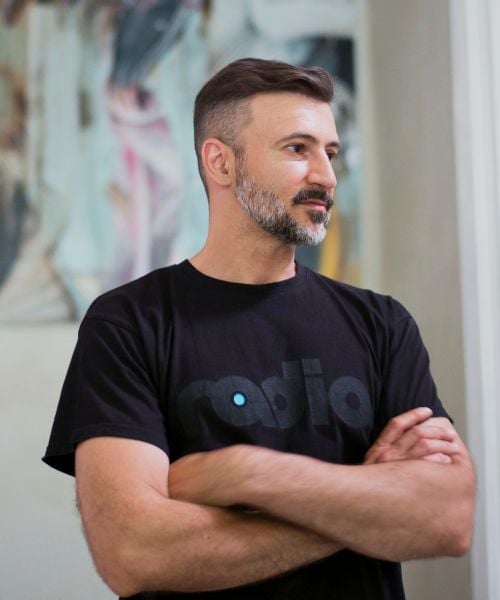
The artist opens up on the eve of a new solo exhibition in London.

Naomi Rea

Money first, art second. That’s how conversations about Adrian Ghenie usually go.
In the art industry, the Romanian painter is a celebrity. Collectors have been clamoring for his semi-abstract compositions since he burst onto the international scene around a decade ago. Today, primary access to Ghenie’s work is tighter than ever, and flippers are having a fiesta. In the first half of this year, his total sales at auction reached $39.3 million, according to Artnet Analytics. In May, his record was busted twice in quick succession, when a painting sold for $9.3 million at Sotheby’s New York and then, seven days later, another hammered down for $10.3 million at Christie’s Hong Kong.
Outside of the art world, few people know who he is. And there’s a reason for that. While most artists would be lucky to reach his level of commercial success at the end of their careers, with multiple museum exhibitions and books to their name, Ghenie is just 45, still developing as a painter, and has yet to notch a solo exhibition at a major institution in the U.S. or the U.K.
I met the artist—dressed inconspicuously in all black and Nike sneakers, accompanied by a gentle aroma of cigarette smoke—at the opening of his latest exhibition, “The Fear of Now,” at Thaddaeus Ropac in London.
On view are 20 new paintings: a series depicting grotesquely distorted visions of Marilyn Monroe that comment on the “soup of fame” and a suite of fragmented, anxious figures being pulled apart by the distractions of 21st century living. Nine charcoal studies complete the presentation.
When I arrived during the install, the gallery hadn’t even started offering the works, which will be priced at €400,000 to €1.5 million for the paintings and €120,000 to €175,000 for works on paper. But selling is not a concern; there is a long waiting list, and Ropac is prioritizing museums. “It’s a big aim to make sure that a good part goes into an institutional context and therefore to place it outside of this danger of speculation,” the dealer told Artnet News.
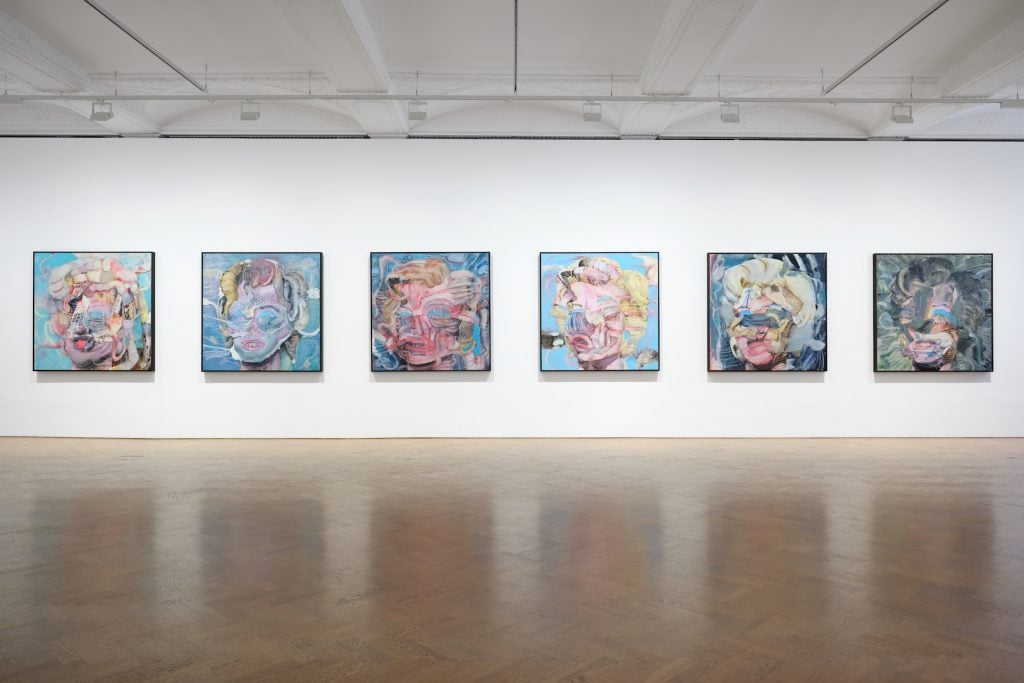
Installation view of “Adrian Ghenie: The Fear of NOW” at Thaddaeus Ropac London. 12 October–22 December 2022. Photo: Jackson Pearce White. © Adrian Ghenie. Courtesy Thaddaeus Ropac gallery, London · Paris · Salzburg · Seoul
The charcoal drawings represent a new direction for Ghenie. Previously, he made preparatory collages for his paintings. “I was always terrified of drawing because I thought it was about precision and I’m the opposite of that,” he said. But discovering a type of paper he could work on with charcoal and erase if he made a mistake changed his relationship to the medium.
The charcoal “rehearsals,” as he calls them, have also made it easier to paint. While he used to work very slowly, producing only around a dozen paintings a year, all 20 paintings in this show are dated 2022. “It was almost like my hand and my brain already knew what to do,” he said of the energetic, intuitive process.
The resulting works contain familiar elements for Ghenie: distorted forms grappling with collective trauma. But instead of drawing on fraught periods of history for inspiration, these paintings invoke contemporary anxieties. The figures slouch, bending over phones or leaning toward laptops, framed by halos of screen light; above their anamorphic heads is a tornado of brain activity.
The best works are self-portraits of the artist in the studio, face obscured in the chaos, at times appearing almost insect-like, as if in the midst of a metamorphosis. They evoke a restless mind, oversaturated from hours of doom scrolling and endless cycles of consumption—items from McDonald’s, Apple, and Adidas are identifiable among the sludge.
“Because of these devices, I have this feeling that I’m not alone anymore,” Ghenie said. “There is this collectiveness inside my studio, which I cannot kick out. It doesn’t let me be alone. But at the same time, I’m not connected either. This limbo, this is what I feel.”
He chain smokes cigarettes in order to quiet the noise.
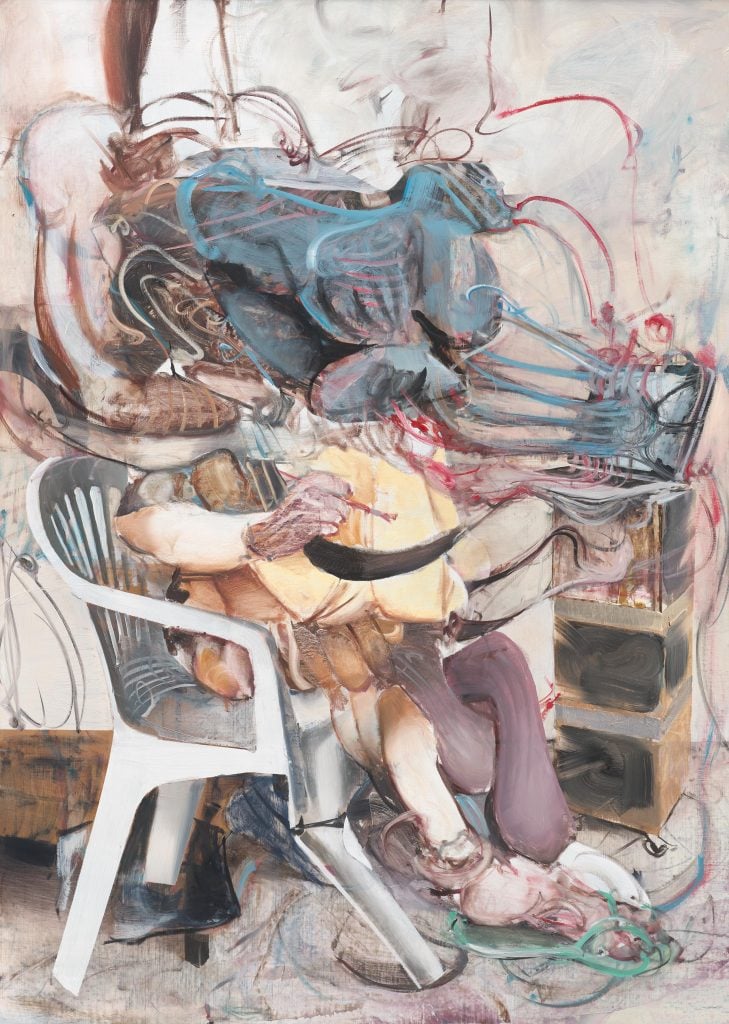
Adrian Ghenie, Studio Scene 1 (2022). ©Adrian Ghenie. Photo: Jörg von Bruchhausen. Courtesy Thaddaeus Ropac gallery, London, Paris, Salzburg, Seoul.
Adrian Ghenie was born in 1977 in Baia Mare, Romania.
His father was a dentist who worked with his mother, a dental technician. Ghenie described an ascetic home environment perfumed with antiseptic. He was fascinated by his parents’ library of medical volumes, whose graphic imagery may have planted early seeds for his aesthetic, which is oft referred to as “Bacon-esque,” a reference to Francis Bacon, the 20th century master of tortured visages.
One book in particular stands out: an antique tome containing black-and-white photographs of early experiments in reconstructive surgery on soldiers after World War I. “It was horrible,” Ghenie said. “It looked like Frankenstein. It looked like a Bacon.”
Other experiences influenced his penchant for the grotesque as well. A particularly hardcore instructor at the University of Cluj took his students to a dingy morgue to teach them about the placement of muscles in the human body. He recalled watching the dissection of a corpse and looking with a morbid fascination and disgust at a shelf of disembodied heads.

Adrian Ghenie, Figure with Remote Control (2022). ©Adrian Ghenie. Photo: Jörg von Bruchhausen. Courtesy Thaddaeus Ropac gallery, London, Paris, Salzburg, Seoul.
Ghenie finished art school in the early 2000s. In post-Soviet, pre-European Union Romania, artistic infrastructure was limited. “If an artist wanted to exhibit, he made his own space,” Ghenie said. Teaming up with a fellow young artist, Mihai Pop, he opened the project space Galeria Plan B in 2005. What happened next, Pop told me, was a series of lucky accidents.
In the 1990s, the Western art community had begun dismantling outdated notions of the “wild East” and mining central Europe for the next art trends, migrating east through Budapest and landing on a rich vein in Romania. Shortly after opening the gallery, Ghenie and Pop were invited to show at the Viennacontemporary fair. “We said, why not?” Pop recalled. “Let’s see how it works in the art market.” Ghenie’s works, priced between €400 to €500, were a huge hit.
Post-Vienna, everything began to take off. Collectors visiting from New York were so enthusiastic that in less than a year, Plan B was invited to participate in the Armory Show (technically against the rules at the time for such a young space, Pop noted). After another fortuitous encounter at the Prague Biennial, the British art critic Jane Neal invited Ghenie and his circle to show in Zurich. Her 2006 exhibition “Cluj Connection” identified the Cluj school as a bonafide art movement, characterized by a serious work ethic, somber subject matter, and a twinge of dry humor. They were mentioned in the New York Times. “The wind was fantastic for us somehow,” Pop said.
After a year operating the gallery together, they reached a crossroads. Ghenie felt he wasn’t right for the business. “I didn’t like interacting with other artists. I realized I like to look at the work, but I don’t have patience for them as people,” he told me. He decided to go back to the studio. Pop decided to commit to becoming a gallerist full-time. Romania had waited a long time to be seen, and someone had to keep up the momentum.
Soon after, an interested dealer, Juerg Judin, invited the lot of them to decamp to Berlin, offering Ghenie a studio space and Plan B cheap rent on a gallery. So they went.
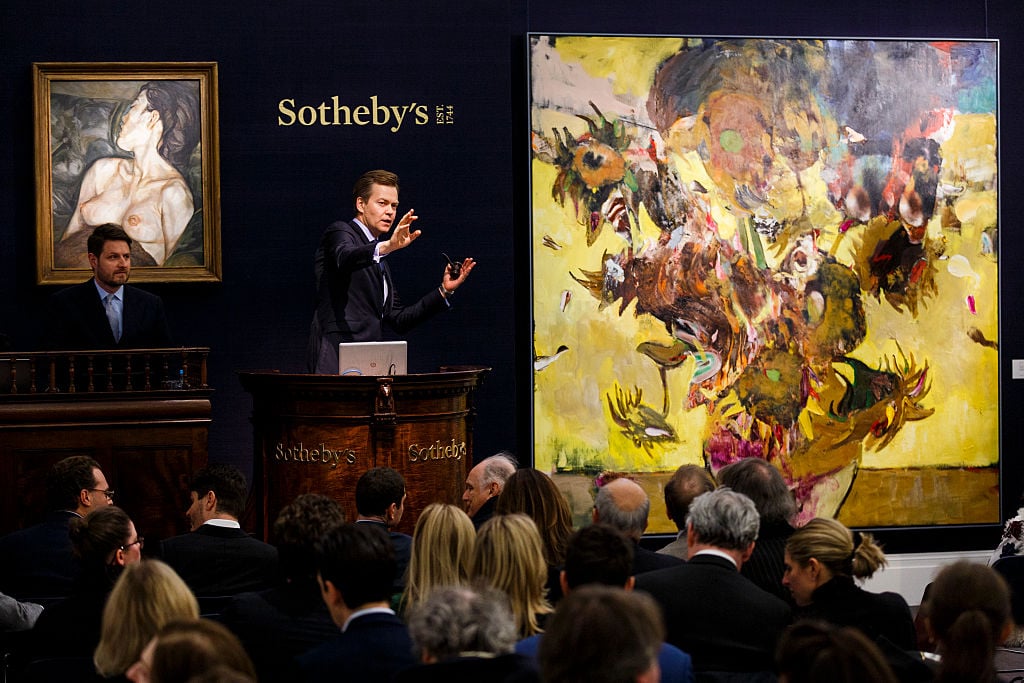
Adrian Ghenie’s Sunflowers in 1937 (2014) is sold at the Contemporary Art Evening Sale at Sotheby’s on February 10, 2016 in London, England. Photo by Tristan Fewings/Getty Images for Sotheby’s.
Ghenie was at the forefront of the excitement building around the Cluj artists. In 2011, he was included in a group show at François Pinault’s Palazzo Grassi in Venice. The same year, he joined Pace Gallery, and prices for his work began to climb. Thaddaeus Ropac heard about him through a friend, U.S. art collector Rodica Seward, a Romanian art lover who had discovered him in Vienna. In 2015, Ghenie was invited to represent Romania at the Venice Biennale, where he showed a divisive installation, Darwin’s Room, which garnered him even more visibility. “I got some enemies,” he said. “But I got some fans too.”
Work first began to appear at auction in 2011, and secondary market prices ballooned so fast that by 2016, one work had already notched $9 million. The furor has not ceased. Ghenie’s work has come to auction 234 times since it first appeared on the block (make that 235 times after Turning Point 1 [2009] goes up at Christie’s London evening sale on Thursday).
Ropac said the most sought-after works are Ghenie’s series from 2008 onwards, like his “Van Gogh” paintings and the “Pie Fights” inspired by a ’40s slapstick movie. But at this point, far more people want Ghenies of any type than can get their hands on them.
All the while, the artist has remained represented by his longtime friend Pop, who has his own theory about why auction prices shot out of control. Demand is driven largely from countries that developed rapidly: China, India, Brazil. Like Romania, which had to race to catch up with the rest of the world after the Iron Curtain fell, these countries accelerated so quickly that they “missed their modernity.” Ghenie’s large-scale, deeply psychological works have more in common with 20th-century Modern art than contemporary painting.
When work with that kind of appeal meets limited direct access on the primary market and vast financial resourcing, auction prices get silly.
Many artists of Ghenie’s stature would have been poached away from the gallery they joined out of grad school. But Pop is an old friend, and Ghenie has a fierce sense of loyalty.
“He’s a permanent member of the family,” Pop said. “He’s feeding the family.” The gallery has been taking part in major art fairs for a decade now, and next week will be debuting at Paris+ by Art Basel with a large Ghenie painting. Ghenie will also inaugurate Plan B’s new space in Berlin in January.
“From one [Ghenie] work, you can cover the costs for an entire year, so then you can really go at your program without any compromise if you want,” Pop said.
Pop paints a picture of Ghenie as down-to-earth, still painting alone without studio assistance and conscious that the music could stop at any moment. Late at night over beers, they reflect on how if it all comes crashing down, they can always go back to Romania and teach high school kids how to paint.
Ghenie also has a generous streak, according to Pop, and has paid for perhaps more scholarships and residencies for people in Romania than the state. He does so quietly, often without checking in on how his money has been spent.
In Berlin, he’s working to build a community of his own. A few years ago, he opened a bar and cinema across the road from his studio called Bar Trauma, now a haven for experimental film and safe space for political activists and the LGBTQ+ community. Pop said Ghenie wanted somewhere to go late at night when he finished painting. Sometimes, he slips behind the bar and plays bartender. “Nobody knows him,” Pop said. “He likes the anonymity.”
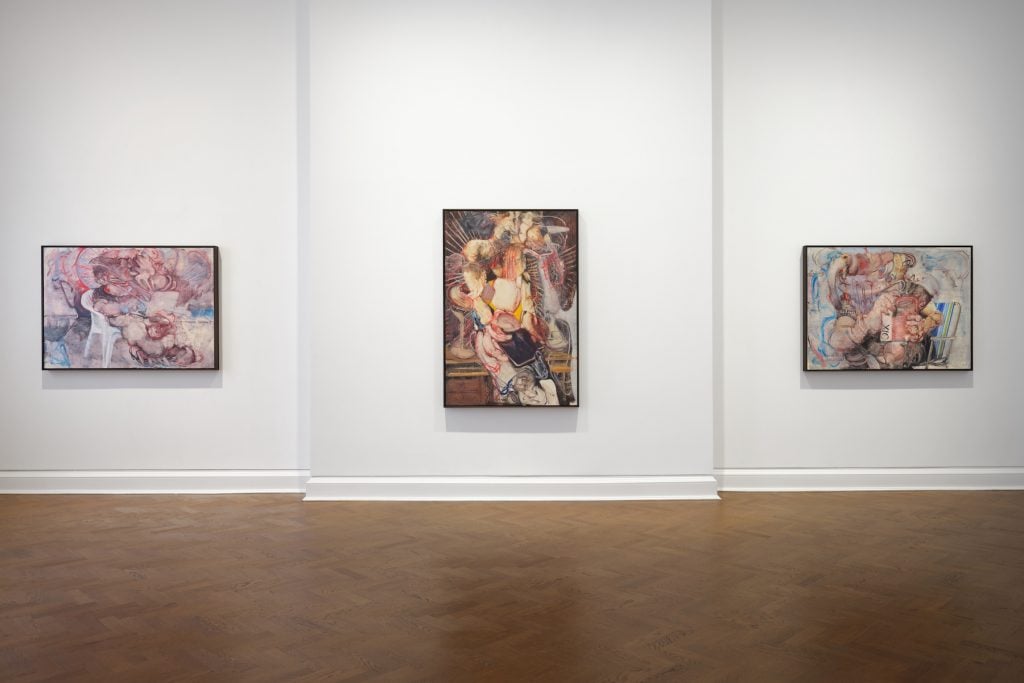
Installation view of “Adrian Ghenie: The Fear of NOW” at Thaddaeus Ropac London. 12 October–22 December 2022. Photo: Jackson Pearce White. © Adrian Ghenie. Courtesy Thaddaeus Ropac gallery, London · Paris · Salzburg · Seoul
Despite the frothy market for Ghenie’s work, he has yet to have a solo exhibition at a major institution in the U.K. or the U.S. The absence of serious institutional attention has led some to christen him a “collector’s artist,” rather than a curator’s artist.
His dealer Ropac was quick to point out that Ghenie has found more success in Europe, with museum shows at the Hermitage and the Cini Foundation in Venice, as well as a presence in the collections of the Pompidou, the Tate, the Met, and many others. (It is unclear how much of this is a result of the increasingly popular dealer strategy of “buy one give one.”)
To date, Ghenie’s only solo museum show in the U.S. has been at the Denver Museum of Contemporary Art in 2012. “I do believe the market’s rapturous embrace of his work has probably put off some museums from engaging more critically and holistically with his work,” said the museum’s director Nora Burnett Abrams, who organized the show. The work’s high valuations and dispersal in collections all over the world adds considerable practical hurdles and expense to organizing a museum presentation, she noted.
Ghenie is under no illusions about this. “Because I was a poster boy for the commercial system for so many years, I think that kind of blocked any discussion about my work in a more objective way,” he said. “Which was never my fault. I was 37 when my works went astronomical.”
Asked what he thinks all this will mean for his place in art history, he demurred. Ghenie has adopted a policy of non-interference when it comes to his public image. “Somehow I want to see how bad it gets,” he said.
Nowadays, people rarely even bother contacting him to ask for an interview, or to let him know when his work will be in a show. “It’s almost like they deal directly with this second person, or third person, I don’t know,” he reflected. “It’s like this person exists and it’s for them more real than me.”
The experience has left him acutely aware of just how little he can control. “It will happen with your co-operation or without it,” he shrugged. “It’s a waste of time to think of anything outside the next painting. The more you shut up, the better.”
Adrian Ghenie, “The Fear of NOW” is on view October 12 through December 22 at Thaddaeus Ropac Gallery, London.
More Trending Stories:
Jameson Green Won’t Apologize for His Confrontational Paintings. Collectors Love Him for It